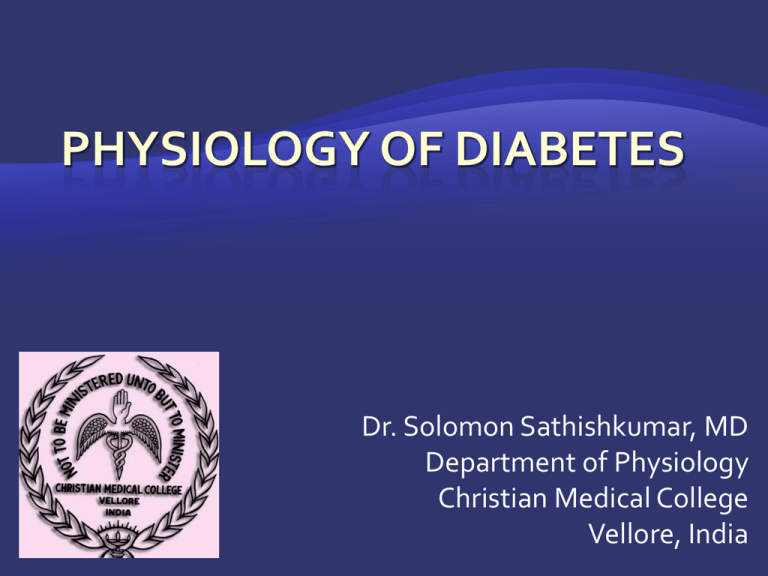physiology-diabetes
advertisement

Dr. Solomon Sathishkumar, MD Department of Physiology Christian Medical College Vellore, India The constellation of abnormalities caused by absolute or relative insulin deficiency is called Diabetes Mellitus. Diabetes is … Characterized by abnormalities in the metabolism of carbohydrate, protein and fat. Associated with micro vascular, macro vascular, and metabolic complications. The adult pancreas is made up of collections of cells called islets of Langerhans There are ~ 1-2 million islets There are four major cell types in the islets of Langerhans http://static.howstuffworks.com/gif/diabetes-pancreas.gif cells - produce insulin Insulin is anabolic increases the storage of glucose, fatty acids and amino acids © 2001 Terese Winslow, Lydia Kibiuk cells- produce Glucagon Glucagon is catabolic: mobilizes glucose, fatty acids and amino acids from stores into the blood stream increases plasma glucose by stimulating hepatic glycogenolysis and gluconeogenesis increases lipolysis in adipose tissue http://besttreatments.bmj.com/btuk/images/diabetespancreas_default.jpg cells - produce somatostatin, which inhibits secretion of insulin, glucagon and pancreatic polypeptide. F (or PP) cells - responsible for the production of pancreatic polypeptide, which slows absorption of food. The amino acid sequence of insulin molecule varies very little from species to species (cows, pigs etc). These differences do not affect the biological activity if insulin from one species is given to another species. but they are definitely antigenic and induce antibody formation against the injected insulin when given over a prolonged period of time. Human insulin is now used to avoid the problem of antibody formation. Insulin is synthesized in the rough endoplasmic reticulum of β cells Insulin is synthesized as a part of a larger pre-prohormone called preproinsulin Release of connecting peptide or C-peptide Enzyme linked receptor http://arbl.cvmbs.colostate. edu/hbooks/pathphys/endocrine/pancreas/insulin_phys.html Insulin binds to the α sub-unit of receptors Triggers tyrosine kinase activity Auto-phosphorylation of β sub-unit Changes in cytoplasmic proteins / enzymes Activation / inactivation of enzymes Actions of insulin Effects of insulin Rapid (seconds): Increased transport of glucose, amino acids, and K+ into insulin sensitive cells. Intermediate (minutes): Stimulation of protein synthesis Inhibition of protein degradation Activation of glycogen synthase and increased glycogenesis Inhibition of phosphorylase and gluconeogenic enzymes (decreased gluconeogenesis) Delayed actions (hours): Increase in mRNAs for lipogenic and other enzymes (increased lipogenesis) On carbohydrate metabolism.. Reduces rate of release of glucose from the liver by inhibiting glycogenolysis stimulating glycogen synthesis stimulating glucose uptake stimulating glycolysis inhibiting gluconeogenesis Increases rate of uptake of glucose into all insulin sensitive tissues, notably muscle and adipose tissue. On lipid metabolism… Reduces rate of release of free fatty acids from adipose tissue. Stimulates de novo synthesis of fatty acids and also conversion of fatty acids to triglycerides in liver. On protein metabolism… Stimulates transport of free amino acids across the plasma membrane in liver and muscle. Stimulates protein synthesis and reduces release of amino acids from muscle. Actions…… Insulin favors movement of potassium into cells. Vigorous treatment with insulin (as in DKA) will cause potassium to move into cells causing hypokalemia. Promotes general growth and development. Insulin Na+ Sodium Potassium ATPase K+ CELL IGF Substances with insulinlike activity include IGF I and IGF II (insulin like growth factors) also called somatomedins. They are secreted by liver, cartilage and other tissues in response to growth hormone. The IGF receptor is very similar to insulin receptor. Glucose enters cells by facilitated diffusion with the help of glucose transporters, GLUT 1 to GLUT 7 GLUT 4 is the glucose transporter in muscle and adipose tissue which is stimulated by insulin Transport of glucose into the intestine and kidneys is by secondary active transport with sodium i.e. via sodium dependent glucose transporters Direct feedback effect of plasma glucose on β cells of pancreas http://biomed.brown.edu/Courses/BI108/BI108_2002_ Groups/pancstems/stemcell/pancreas.gif ATP gated K+ channel Beta cell Stimuli that increase cAMP levels in β cells increase insulin secretion probably by increasing intracellular Ca 2+ GLUT 2 Glucose Uptake Glucokinase K+ ATP Depolarization Insulin Release Ca++ Storage granules Voltage gated Ca++ channel • β adrenergic agonists • Glucagon • Phosphodiesterase inhibitors such us Theophylline Tolbutamide and other sulfonylurea derivatives. Biguanides (Metformin or Glyciphage) decrease hepatic gluconeogenesis Thiazolidinediones (Rosiglitazone etc) increase insulin sensitivity by activating Peroxisome Proliferator-Activated Receptor (PPARγ) receptors in the cell nucleus Sympathetic nerve stimulation to pancreas inhibition of insulin secretion Parasympathetic stimulation to pancreas increase in insulin secretion Orally administered glucose has a greater insulin stimulating effect than intravenously administered glucose This led to the possibility that certain substances secreted by the gastrointestinal mucosa stimulated insulin secretion. Glucagon, glucagon derivatives, secretin, cholecystokinin and gastric inhibitory peptide, all have such an action. = The increase of insulin secretion after oral as opposed to intravenous administration of glucose. The two most important Incretin hormones: Glucose-dependent insulino-tropic polypeptide (GIP), formerly known as gastric inhibitory polypeptide Glucagon-like peptide (GLP-1), an additional gut factor that stimulates insulin secretion. Glucagon-like polypeptide 1 (GLP-1) GLP-1 is synthesized within L cells located predominantly in the ileum and colon, and a lesser number in the duodenum and jejunum. GLP-1 stimulates insulin secretion, suppresses glucagon secretion, slows gastric emptying, reduces food intake, increases β cell mass, maintains β cell function, improves insulin sensitivity and enhances glucose disposal. The glucose lowering effects of GLP-1 are preserved in type 2 diabetics. However, native GLP-1 is rapidly degraded by dipeptidyl peptidase- IV(DPP-IV) after parenteral administration. GLP-1 receptor (GLP-1R) agonists and DPP-IV inhibitors have shown promising results in clinical trials for the treatment of type 2 diabetes. Chronic disorder characterized by fasting hyperglycemia or plasma glucose levels that are above defined limits during oral glucose tolerance testing (OGTT) or random blood glucose measurements, as defined by established criteria. Plasma glucose values Diagnosis AC - 100 – 126 mg% Impaired fasting glucose AC - > 126 mg% Diabetes 2 hr PC: 140 – 200 mg% Impaired glucose tolerance 2 hr PC: > 200 mg% Diabetes Type 1 Diabetes Immune mediated, absolute insulin deficiency due to autoimmune destruction of β cells in the pancreatic islets Genetic Susceptibility Islet Auto Antibodies attack Beta cells β cell destruction Environmental Factors / Viral infection Insulin deficiency++ Type 1 Diabetes Type 2 Diabetes Individuals with insulin resistance or insensitivity of tissues to insulin (later leading to impaired insulin secretion). Maybe due to deficiency of GLUT 4 in insulin sensitive tissues, or genetic defects in the insulin receptor or insulin molecule itself. Excess food Low Birth weight Obesity Beta cell defect Genetic Motorization TV Beta cell Secretory defect Insulin Resistance in Target cells Relative Insulin Deficiency Sedentary lifestyle β cell exhaustion Type 2 Diabetes (T2D) May need Insulin Hyperglycemia Glycosuria Polydypsia Polyuria Polyphagia Ketosis, acidosis, coma eventually death if left untreated Reduced entry of glucose into various peripheral tissues Increased liberation of glucose into circulation from liver. Therefore there is an extracellular glucose excess and in many cells an intracellular glucose deficiency – “starvation in the midst of plenty”. Various signs and symptoms in diabetes are due to disturbances in carbohydrate, protein and lipid metabolism. Polyuria, Polydypsia and Polyphagia Consequences of disturbed carbohydrate metabolism Polyuria, polydypsia and polyphagia The renal threshold for glucose is 180 mg% i.e. if the plasma glucose value is raised above 180 mg%, glucose will start appearing in urine (glycosuria). Thus, as glucose is lost in the urine, it takes along with it water (osmotic diuresis) leading to increased urination (polyuria). Since lot of water is lost in the urine, it leads to dehydration and increased thirst (polydypsia). Electrolytes are also lost in the urine. The quantity of glucose lost in urine is enormous and thus to maintain energy balance the patient takes in large quantities of food. Also because of decreased intracellular glucose, there is reduced glucose utilization by the ventromedial nucleus of hypothalamus (satiety center) and is probably the cause for the hyperphagia. Way of looking at average blood sugar control over a period of 3 months. Glucose in the blood Haemoglobin in the blood Glycated haemoglobin Controlled diabetes: Not much glucose Not much Glycated haemoglobin Uncontrolled diabetes: More glucose Much more Glycated haemoglobin Hyperglycaemia High intracellular glucose levels Aldose reductase (enzyme) activation Sorbitol formation ↓ Sodium potassium ATP-ase activity Glucose attaches (non-enzymatically) to the protein amino groups amodari products Advanced glycosylation end products (AGEs) cause cross linkage of matrix proteins Damage to blood vessels ↑ Sorbitol and fructose in Schwann cells disruption in their structure and function circulatory insufficiency due to atherosclerosis neuropathy protein depletion causes poor resistance to infections AGEs cause a decrease in leukocyte response to infection Consequences of disturbed lipid metabolism The principal abnormalities are acceleration of lipid catabolism with increasing formation of ketone bodies and decreased synthesis of fatty acids and triglycerides. Acidosis and ketosis is due to overproduction of ketone bodies (acetoacetate, acetone and β-hydroxybutyrate). Most of the hydrogen ions liberated from acetoacetate and βhydroxybutyrate are buffered, but still severe metabolic acidosis still develops. The low pH (metabolic acidosis) stimulates the respiratory center and produces the rapid, deep, regular kussmaul breathing. Coma / death Fruity odour Kussmaul breathing Low Insulin Liver Accelerated lipid catabolism ↑ Ketone Bodies Ketonuria Metabolic Acidosis The acidosis and dehydration can lead to coma and even death. Hormone-sensitive lipase Triglycerides Free fatty acids (FFA) + glycerol Insulin inhibits the hormone sensitive lipase in adipose tissue and in the absence of insulin, the plasma level of FFA doubles. In liver and other tissues, the FFA are catabolized to acetyl Co A, and the excess acetyl Co A is converted to ketone bodies. ↑ protein breakdown muscle wasting ↓ protein synthesis ↑ plasma amino acids and nitrogen loss in urine leading to negative nitrogen balance and protein depletion. Protein depletion is associated with poor resistance to infections. In diabetics, the cholesterol level is usually elevated leading to atherosclerotic vascular disease This is due to a rise in the plasma concentration of VLDL and LDL (which maybe due to increased production by the liver or decreased removal from circulation) Micro vascular complications like retinopathy, nephropathy and neuropathy involving the peripheral nerves and autonomic nervous system. Macro vascular complications like stroke, peripheral vascular disease and myocardial infarction due to increased atherosclerosis caused by increased amounts of LDL. Thank you







